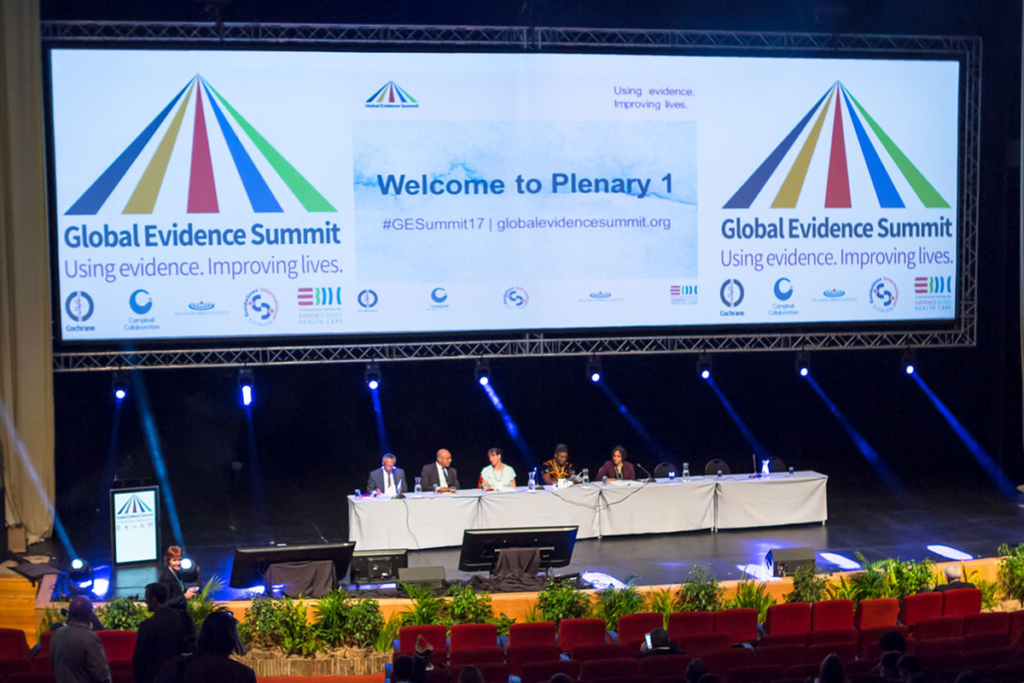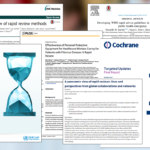A couple of weeks ago, I was fortunate to attend the Global Evidence Summit (GES) in Cape Town, South Africa. GES was billed as being the first conference of its kind, jointly organized by the Cochrane Collaboration, the Campbell Collaboration, and several other groups to focus on evidence-based policymaking across sectors. Those of us who attended the What Works Global Summit in London last September considered GES the second conference of its kind, and we were excited to reconnect with each other this year in Cape Town.
The conference brought together researchers and policy analysts in the fields of health, education, and international development to explore that long and often tortuous path between a single study and a policy or program that is evidence based. Sessions covered topics such as evidence mapping, systematic reviews, rapid reviews, standard and guideline setting, big data, and policy engagement. In this post, I report on what I learned about evidence networks in the first day’s plenary. For readers interested in learning more about the conference itself, I provide a quick review at the end of the post.
Ruth Stewart, the Director of the Africa Centre for Evidence at the University of Johannesburg, was the first speaker in the first day plenary session called Evidence for Africa. She addressed the question, do evidence networks make a difference? Her short answer was yes. She used a term (and diagram) that several others used during the conference: evidence ecosystem. The evidence ecosystem is really just a circular version of that long and often tortuous path between a single study and a policy or program. Several speakers had good evidence ecosystem slides, but I never managed to take a picture at the right moment. Here is one tailored to health that I found online. (It is interesting that this one does not put basic research at the top.)

Image credit: MAGIC Project
Stewart’s argument was that evidence networks improve the workings of the evidence ecosystem in three ways.
- They create a better understanding of the evidence ecosystem.
- They increase the capacity of those within the evidence ecosystem.
- They create greater potential for change.
Her first point was that evidence networks, by bringing together different actors within an evidence ecosystem, increase the understanding among them both of who else is in the network and also of how evidence-informed decision making works. In short, relationships improve common understanding.
The second point about building capacity certainly encompasses the standard idea of building the capacity of evidence users to interpret and apply evidence, but Stewart highlighted capacity building in other directions. She told a story about delivering a workshop on evidence use for public servants where she felt like she learned more from them about their role in the evidence ecosystem than they learned from her. What she learned from them benefits her work in the ecosystem. This kind of shared capacity building also enhances respect for actors throughout the system. In addition, evidence networks often involve actors from different sectors, and we can learn much from the evidence and experiences of other sectors.
The third point was a bit more nuanced. Stewart cited Duncan Green’s book How Change Happens to make the case that big changes are generally triggered by events, so we need to be ready for when those triggers occur. Evidence networks help us to be ready for those triggers, to be able to bring evidence to bear quickly when the opportunities for change arise. For Stewart, greater potential for change comes from greater readiness for change, which is aided by evidence networks.
Stewart concluded by admitting that it is hard to produce evidence that evidence networks make a difference. Ironic, but understandable. Nonetheless, she convinced me of the benefits of evidence networks.
As noted above, the full plenary session on the first day was titled Evidence for Africa. The second speaker, Patrick Mbah Okwen, a Research Fellow at the Centre for Development of Best Practice in Health in Cameroon, asked the question, can we get to best current evidence in practice? I won’t summarize his full speech here, but I found one part particularly notable. He listed three barriers to evidence use in primary health care in Africa: paucity of evidence, lack of access to journals, and limited capacity to use evidence (whether from primary studies, syntheses, or guidelines). His focus was primary care providers in Africa, but of course these barriers affect all those working in (and on) all low- and middle-income countries. If you are not at a university, obtaining articles from non-open-access journals is very expensive. I rarely see practitioners in the NGO sector accessing journals. In addition, the evidence base across sectors for low- and middle-income countries is growing but still limited.
GES was a great conference, and I hope to write more blog posts about specific sessions or inspired by what I learned there. One thing I enjoyed about GES was the quality of the plenary sessions. While plenary speeches can often be bland, most of the GES plenary speakers put together detailed presentations and made compelling arguments, and most were also good speakers. Another highlight of the conference for me was the quality of the posters. I took a lot of pictures of them and collected some handouts so that I can refer to them for my work. I hypothesize, however, that the quality of the posters was a direct outcome of the small number of oral abstract sessions. It seemed that the special sessions were given priority, and indeed many were well planned and interesting. But adding more oral abstract sessions to the program would have allowed more diversity in the research presented, and probably would have allowed more of those who submitted abstracts to attend the conference.
To view quotes and photos from the conference, check out #GESummit17 on Twitter.
Next year the conference is called the Global Evidence and Implementation Summit and will be held in Melbourne, Australia in October. I encourage you to check it out and mark your calendars!
Image credit: Steven Booth; Global Evidence Summit 2017



